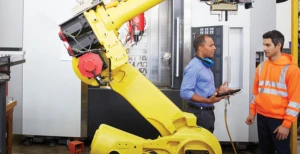
The Intelligent Service Technician: Empowering Field Service with Smartglasses
As we return from Microsoft’s largest customer showcase (US Convergence in Atlanta), one of the highlights our manufacturing team wanted to share was our demonstration with APX Labs showing how Smartglasses technology works with Microsoft in field maintenance and service scenarios.
An important element of transforming your organization into an “Intelligent” ecosystem, is looking at each business unit with a focus on driving efficiency, collaboration, and productivity. This is not simply accomplished by introducing technology but rather by focusing on the people and processes which enable this critical evolution for your company.
Likely no group within your organization has more potential for cost savings, net new revenue, and improved productivity than your field service team. Gartner Research finds that Smartglasses will “save the field service industry $1B per year” in 2017. Whether these resources are direct employees or outsourced thru a channel, it’s likely the first area you should prioritize. This important workforce has often been ignored because of a lack of practical interface options. Historically the market simply lacked relevant form factors to truly drive productivity in work environments where a keyboard was not practical.
One new interface that is gaining a lot of attention is Smartglasses. These particular devices have long been watched with particular interest from those responsible for field service, break fix, and maintenance tasks due to the high potential for a hands free experience. Our Microsoft team has been working with APX Labs to connect a specific type of Smartglasses to create relevant “augmented reality” scenarios. We created integration to a number of our solutions including: Microsoft Dynamics CRM and Microsoft Dynamics AX 2012, Skype, Office 365, Bing Maps, and other Microsoft technologies. To see these technologies come to life thru Smartglasses was exciting but the interaction they allowed with field service technicians was the real payoff.
Our scenario started with an Internet of Things (IoT) enabled machine alerting dispatch (based on defined criteria) that an inspection was needed – and likely repair. Microsoft Dynamics CRM managed the logic routing notification to dispatch for assignment to the service rep. However, what excited the attendees at Convergence 2015 was a live scenario showing the view of a service agent looking thru smart glasses to perform a checklist of tasks. Upon arrival at the site a checklist appeared in the display showing visuals for each step. Walking thru a series of tasks, the agent escalated an unknown issue by interacting hands free with a supervisor via Skype.
This scenario demonstrates the benefits of video and audio interaction while on the repair site, receiving guidance from a senior tech with more experience, instructive diagrams, and sample videos that drove faster, first visit resolution of the issues. Implicit is the benefit of user productivity, decreased down time, safety, and compliance.
The first internet revolution brought huge productivity gains to knowledge workers via desktops, laptops, tablets and smartphones. The coming revolution will do the same for hands-free workers (e.g. on the manufacturing line, on a utility pole, in a biotech lab, inspecting pipelines, under the hood of construction equipment, or in a warehouse). By combining a set of solutions you likely already own with a Smartglasses interface (we used Epson Moverio), we are able to demonstrate a solution that can reinvent productivity, today.
This serves as a great example of Microsoft continuing in its quest to drive role-based productivity with software and hardware. Whether the interface is smart phones, tablets, interactive screens, or other methods of displaying rich, visual data, the opportunity is not to simply view information but allowing user response and interaction.
For more, visit our booth at Hannover Messe event next week, or watch keynotes from US Convergence 2015. For more information, we encourage you to email the Dynamics manufacturing team at [email protected] or contact our local teams to engage in a personal demo of solutions like this from Microsoft and its partners. If you are ready for a Smartglasses pilot program or hands on demo, please contact APX Labs.
UPDATE: For a deeper dive into the Smartglasses demo mentioned in this blog post, hear and see Microsoft technical architect Alex Anikiiev explain how companies can implement industry scenarios using Microsoft Dynamics AX, Microsoft Dynamics CRM, and a broad range of Microsoft Azure IoT services on this recorded webcast at MSDynamicsWorld.com




